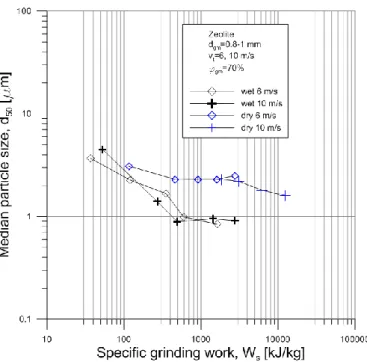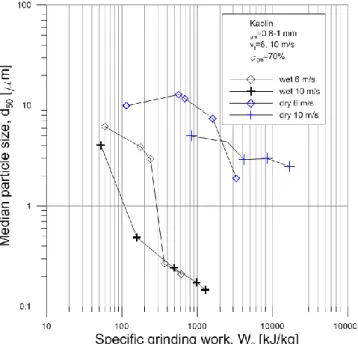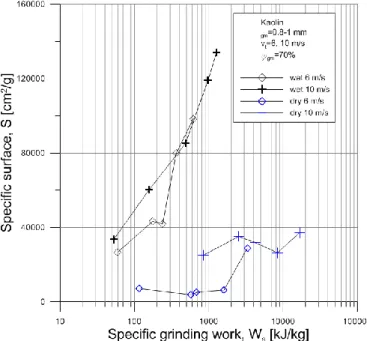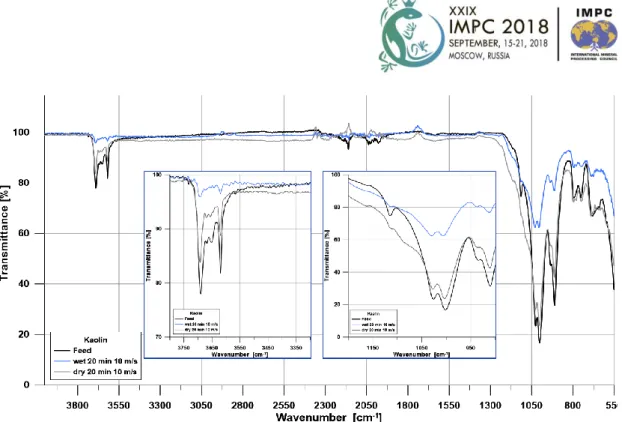1 Institute of Raw Material Preparation and Environmental Processing, University of Miskolc, Hungary, 3515 Miskolc-Egyetemváros
2 Institute of Mineralogy and Geology, University of Miskolc, Hungary, 3515 Miskolc-Egyetemváros (*Corresponding author: ejtracz@uni-miskolc.hu)
ABSTRACT
Stirred media mills are widely used in the industry for fine grinding. Most of the applications work in wet mode, however dry grinding in stirred media mill comes forward more frequently nowadays. The present paper deals with the differences and similarities of the wet and dry grinding in stirred media mill from energetic and mechanochemical point of view as well. Grinding experiments in batch stirred media mill were carried out with different materials. During the experiments zeolite and kaolin were used as feed material. The grinding experiments were carried out at different stress energy and stress number values; the grinding work was measured during milling. After grinding X-ray diffraction (XRD), Fourier Transform Infrared Spectroscopy (FTIR), particles size analyzes by laser scattering were carried out on the ground materials. As a result of the systematic grinding and analytical measurements a comprehensive comparison was carried out on the wet and dry grinding and their usefulness for mechanical activation in stirred media mill.
KEYWORDS
Stirred media mill, wet and dry grinding, mechanical activation.
INTRODUCTION
The natural zeolites are crystalline hydrated aluminosilicates of alkali and alkaline earth characterized by the structure that contains frameworks responsible for the high cation exchange capacity (CEC) and absorption capacity. The frameworks are interconnected by cavities and resided by cations variable in size, coordinated by water molecules. Since zeolite comprises SiO4 and AlO4 tetrahedra interlocked by oxygen atoms that are situated in the structural nodes, their characteristics differ due to the varieties in the structure-directing agents and Si/Al ratio (Colella and Wise, 2014;
Malekian et al., 2011; Terzić et al., 2017). The most common natural zeolite occurring in high amount, of industrial importance and involved in milling and MA is the clinoptilolite, in the literature equivalent to “natural zeolite” designated for high clinoptilolite bearing volcanic tuffs. Its amount in the host rock must reach ~ 40 % by weight to obtain the CEC and adsorption desired in its
of the tuffaceous rock. The application of such natural zeolites is problematic in many cases due to high silica (quartz, cristobalite and volcanic glass) content and beneficiation (concentration and extraction of pure zeolite) are not feasible. Thus, mechanical activation is a possible way to alter the other than clinoptilolite minerals generating high specific surface area and functionalized particle surfaces to enhance adsorption, reaction or particle adhesion. The zeolites easy availability and the utilization cost-effectiveness have prompted the research on their physicochemical and structural properties (e.g. adsorptive and molecular-sieve activity, heat resistance, and microporous cage structure) and finding new options for their application (Kusuma et al., 2013; Musyoka et al., 2014;
Rida et al., 2013; Terzić et al., 2015b). Apart from the presence of exchangeable framework cations which are crucial for the adsorption ability, and a certain degree of pozzolanic reactivity. The thermal stability of dehydrated phases is another important characteristic for use of the zeolite in composite materials that are exposed to high temperature. Thereby, the zeolites found a wide application possibility in the design of the construction composites (Albayrak et al., 2007; Najimi et al., 2012;
Vejmelková et al., 2015), as well as for resolving of the environmental protection issues like wastewater refining or heavy metal elimination (Gómez-Hortigüela et al., 2014) even from contaminated groundwater using passive methods like permeable reactive barriers (Gombkötő et al, 2016). The grinding treatment of zeolite is a common and frequently applied procedure, both on laboratory (Bohács et al. 2017, Faitli and Czél, 2014) and industrial scale when certain characteristics of the zeolitic minerals should be improved to enhance the overall performance of the final zeolite- based composite. However, during the grinding process in high energy density mills, mechanochemical reactions can take place in zeolites.
Industrial utilisation of kaolin covers a wide range of applications including the production of ceramics, paper, paints, plastics, rubber, ink, cracking catalysts and adsorbents, depending on the physical, chemical, structural, and surface properties of kaolinites (Murray et al 1993). One of the rapidly developing application areas is of inorganic polymers (geopolymers) (Davidovits 1991, Duxson et al 2007) where kaolin plays an important part as raw material. The physical, chemical, structural and surface properties of kaolinite can be significantly modified by mechanochemical activation through dry grinding (Torres et al. 1999, Frost et al. 2001, Makó et al. 2001, Vizcayno et al.
2010, Balczár et al 2016).
The goal of the presented work was to carry out a comparative investigation of mechanical activation of zeolite and kaolin in stirred media mill in various media, wet and dry state from energetic and mechanochemical point of view.
MATERIALS AND METHODS
The wet and dry grinding experiment was carried out in a batch horizontal stirred media mill equipped with a high-wear-resistance (Al2O3) liner and stirring discs. The mill is double-walled to cool the grinding chamber. The useful volume is 530 cm3. The operation of the motor is regulated by a
frequency controller, so the rotor’s revolutions per minute and circumferential speed could be adjusted.
The mill engine’s power requirement was measured by a microcomputer-controlled digital energy meter (Carlo Gavazzi 70). During the grinding experiment 0.8-1 mm zirconium silicate grinding media were used with a 70% media filling ratio. During the dry and wet grinding the same amount of feed material was used, in case of the zeolite 31.92 g; in case of the kaolin 32.05 g. The grinding times were 1, 3, 5, 10 and 20 min, the applied rotor circumferential velocities were 6 and 10 m/s. The median particle size of the feed d50=20.14 µm was in case of zeolite and d50=8.21 µm in case of kaolin.
The particle size distribution (PSD) of the raw and the ground materials was measured by HORIBA LA-950V2 laser diffraction particle size analyzer in wet mode using distilled water as dispersing media. The geometric (outer) specific surface area (S) was calculated using PSD data by the laser sizer software.
The composition of the ground products was investigated by using a JASCO 4200 type Fourier Transformed Infrared Spectrometer (FT-IR) in reflection mode with diamond ATR. Stretching and bending vibrations of chemical bonds were used to observe the transformation of primary components and to detect newly forming materials.
The mineralogical composition was determined by a Bruker D8 Advance XRD powder diffractometer (Cu-Kα radiation, 40kV, 40mA) in parallel beam geometry (Göbel-mirror). Patterns were recorded in 2-70° (2θ) range, with 0.007° (2θ) steps in 42 seconds, with Vantec-1 position sensitive detector (1°
window opening). Phase identification was made by Search/Match (multiple iteration) on ICDD PDF2 (2005). Quantitative evaluation was made by Rietveld-refinement in TOPAS4 software, using FPM based instrumental convolution (using SRM 640d Si), with crystal structure data from AMCSD database.
The chemical composition of the raw materials was determined using a Rigaku Supermini X-ray Fluorescence apparatus (Table 1).
Table 1 Chemical Composition of the feed
SiO2 Al2O3 MgO CaO Na2O K2O Fe2O3 MnO TiO2 P2O5 S Zeolite
75,4 12,2 0,76 1,80 0,27 4,66 1,31 0,035 0,089 0,010 <0.005
Kaolin53,4 33,7 0,25 0,24 0,11 1,10 1,96 0,006 1,048 0,013 0,061
The zeolitic rhyolite tuff, hereinafter natural zeolite, is a compacted and silica-cemented porous material, with a material density of 2230 kg/m3, originated from Rátka deposit, Hungary. Its main mineral components were identified as clinoptilolite, orthoclase, cristobalite and quartz by XRD measurement. Since the deposit was formed by low-temperature hydrothermal alteration of rhyolite tuff, large variation in clinoptilolite content is frequent. However, the 35-55 % by weight is the characteristic domain, with low clay mineral content for the Rátka occurrence. The kaolin originated from, Romania with a material density 3070 kg/m3.
RESULTS AND DISCUSSION
The results of the grinding experiments are summarized in Fig 1-4. The median particle size as a function of the specific grinding work can be seen in Fig 1 in case of zeolite grinding. The lowest median particle size was achieved by wet grinding, its value was 840 nm. The lowest median size in case of dry grinding was 1.6 µm. At all specific grinding work the dry grinding resulted in higher median particle sizes than the wet ones. The 6 and 10 m/s rotor velocities and thus the different stress energies did not have significant effect in the median particle size in the measured range. In case of the wet grinding until 500 kJ/kg specific grinding work the median particle size decreased significantly, however higher specific grinding works did not resulted in lower median size, at 6 and 10 m/s as well.
With the applied grinding parameters lower median size than 840-900 nm could not reached by wet grinding. In dry grinding a fast decrease of the median size was achieved at the beginning of grinding, since median of the ground material decreased from 20.14 µm to 4-5 µm by 30-40 kJ/kg specific grinding work. However after 500 kJ/kg specific grinding work the median size stagnate, and after 2000 kJ/kg started to decrease further at the higher stress energy.
Fig 1 Median particle size as a function of specific grinding work in case of zeolite grinding
The median particle size as a function of the specific grinding work can be seen in Fig 2 in case of kaolin grinding. The lowest median particle size was achieved by wet grinding, it value was 147 nm. The lowest median size in case of dry grinding was 1.88 µm. At all specific grinding work the dry grinding resulted in higher median particle sizes than the wet one. The 6 and 10 m/s rotor velocities and thus the different stress energies showed significant effect in the median particle size in the measured range. In wet grinding at under 400 kJ/kg specific grinding work the higher
circumferential speed, thus higher stress energy was sufficient, while at higher specific grinding works the median particle sizes were nearly the same in both stress energies. In dry grinding the higher stress energy grinding was more effective, however the lowest median size was reached by the 6 m/s and thus lower stress energy grinding. In case of wet grinding the median particle size decreased significantly and continuously with the specific grinding work in the measured range.
Fig 2 Median particle size as a function of specific grinding work in case of kaolin grinding
The specific surface area of the ground material as a function of the specific grinding work can be seen in Fig 3 in case of zeolite grinding. Wet grinding resulted in significantly higher specific surface at same specific grinding work than the dry one. The higher stress energy in wet operation resulted in higher specific surface than the lower one until 500 kJ/kg, however at higher works at 10 m/s velocity the specific surface didn’t increase further, but the lower 6 m/s did. The highest specific surface (cca. 32 000 cm2/g) was achieved by wet grinding at 6 m/s rotor velocity. In dry grinding the results of the 6 and 10 m/s grinding were close to each other under 2000 kJ/kg specific grinding work, but at higher ones the 10 m/s grinding resulted in much higher specific surfaces.
Fig 3 Specific surface as a function of specific grinding work in case of zeolite grinding
The specific surface area of the ground material as a function of the specific grinding work can be seen in Fig 4 in case of kaolin grinding. Wet grinding resulted in significantly higher specific surface at same specific grinding work than the dry one. In wet grinding the 10 m/s rotor velocity resulted in higher specific surfaces until 400 kJ/kg specific grinding work, above the results are very close to each other. The highest specific surface was achieved by wet grinding at 6 m/s rotor velocity.
In dry grinding of kaolin the 10 m/s rotor velocity proved much more successful from the specific surface point of view in the all investigated specific grinding work range.
Fig 4 Specific surface as a function of specific grinding work in case of kaolin grinding
FTIR data is suitable to track the crystalline or amorphous nature of silicate materials, beyond water, hydroxyl, carbonate, and other anion contents. Unfortunately, its applicability in such complex materials as in our case is problematic, due to multiple overlapping of adsorption bands. Hereby we illustrate the main change in the structure of zeolite and kaolin.
Fig 5 FTIR results of feed and ground zeolite samples
In case of zeolite Fig 5 shows the samples of the feed, dry and wet grinding after 20 minutes, 10 m/s rotor velocity. The circumferential velocity of the rotor did not have a significant effect on the FTIR results, so in the figure only the results of the 10 m/s grinding are presented. The 3600 cm-1 band (hydroxyl of illite) is reduced during grinding, however, in wet grinding the rate of reduce is much less than in dry grinding. Furthermore, the band became wider because of wet grinding. In dry grinding the intensity of the 1627 cm-1 band of H-O-H bending is reduced, the same can be seen in the 795 cm-1 band symmetric stretching vibration of Si-O-Si(Al). The asymmetric stretching vibration (Si(Al-O) 1010 cm-1 is shifted toward 1024 cm-1 because of dry grinding, and the band became wider as well. In wet grinding of zeolite, the development of the shoulder in the 870-890 cm-1 wavenumber region was observed. The band at 1010 cm-1 asymmetric stretching vibration (Si(Al-O) is shifted toward 1014 cm-1 because of wet grinding, but the band did not become wider.
Fig 6 FTIR results of feed and ground kaolin samples
In case of kaolin Fig 6 shows the samples of the feed, dry and wet grinding after 20 minutes, 10 m/s rotor velocity. The circumferential velocity of the rotor did not have a significant effect on the FTIR results, so in the figure only the results of the 10 m/s grinding are presented. In dry grinding of kaolin, the bands 3680-3690 cm-1; 3619 cm-1 and 1114 cm-1 almost disappeared. The intensity of bands 1624-525 cm-1 was reduced significantly because of grinding. In wet grinding of kaolin compared to the dry one, not so significant band intensity decrease was observed. A new band at 779 cm-1 was formed.
Phase Name [wt%]
Dry 5 min 10 m/s
Dry 10 min 10 m/s
Dry 20 min 10 m/s
Wet 5 min 10 m/s
Wet 10 min 10 m/s
Wet 20 min 10 m/s Clinoptilolite-(Ca,K) 19,27 17,53 8,69 29,18 26,18 27,94 Cristobalite low 11,11 12,44 9,21 10,69 11,23 9,02
Quartz 5,84 5,39 4,39 5,10 4,40 4,90
Sanidine Na0.16 14,41 14,59 9,68 15,39 12,98 13,08
Illite 2M1 3,50 3,96 2,29 5,46 5,46 5,63
smect 13A 3,15 2,42 0,28 9,00 7,14 6,40
Heulandite 4,61 6,85 1,26 8,51 5,28 0,59
Albite 1,12 1,23 0,01 1,67 1,33 1,23
ZrO
2monoclinic 0,98 2,59 6,19 2,95
Calcite 2,25
amorphous 36,00 33,00 58,00 15,00 26,00 26,00
Table 2 Results of XRD analyzes in case of zeolite grinding
Table 2 shows the results of the XRD analyzes of zeolite ground samples. The results of the wet and dry grinding of zeolites at 10 m/s rotor velocity are presented at different grinding times. In dry grinding the amount of the amorphous phase is increasing with the grinding time, while the clinoptilolite decreasing. In case of wet grinding, the amorphous phase increasing, however, compared to the dry grinding the amount of the amorphous phase is lower.
CONCLUSIONS
Based on the measurement results the following conclusions can be drawn. The wet stirred media milling was much more effective than the dry one from the size reduction point of view in kaolin and zeolite grinding as well. However more significant changes were observed in the structure during dry grinding based on FTIR measurements. Dry grinding is more effective in amorphisation, than wet grinding, as observed from the evolution of amorphous fraction based on XRD. More progressive crystallite size decrease and amorphous fraction increase is observed with the higher energy grinding.
ACKNOWLEDGEMENTS
The research work was supported by the János Bolyai Research Scholarship of the Hungarian Academy of Sciences. The described work/article was carried out as part of the „Sustainable Raw Material Management Thematic Network – RING 2017”, EFOP-3.6.2-16-2017-00010 project in the framework of the Széchenyi2020 Program. The realization of this project is supported by the European Union, co-financed by the European Social Fund. The research work was performed in the framework of the Centre of Excellence in Sustainable Natural Resource Management at the Faculty of Earth Science and Engineering, University of Miskolc. Supported BY the ÚNKP-17-3-III-ME/27 New National Excellence Program of the Ministry of Human Capacities.
REFERENCES
Reference to a journal publication:
Albayrak, M., Yörükoğlu, A., Karahan, S., Atlıhan, S., Yılmaz Aruntaş, H., Girgin, İ., 2007.
Influence of zeolite additive on properties of autoclaved aerated concrete. Build. Environ. 42, 3161–
3165. https://doi.org/10.1016/j.buildenv.2006.08.003
Balczár I, Korim T, Kovács A, Makó É, Mechanochemical and thermal activation of kaolin for manufacturing geopolymer mortars – Comparative study, Ceramics International 42 (2016) 15367–
Bohács, K., Faitli, J., Bokányi, L., Mucsi, G., 2017. Control of Natural Zeolite Properties by Mechanical Activation in Stirred Media Mill. Arch. Metall. Mater. 62. https://doi.org/10.1515/amm- 2017-0216
Colella, C., Wise, W.S., 2014. The IZA Handbook of Natural Zeolites: A tool of knowledge on the most important family of porous minerals. Microporous Mesoporous Mater. 189, 4–10.
https://doi.org/10.1016/j.micromeso.2013.08.028
Davidovits J, Geopolymers: inorganic polymeric new materials, J. Therm. Anal.
37(1991)1633–1656.
Duxson P, ,A. Fernández-Jiménez ,J. L. Provis, G.C. Lukey, A. Palomo, J.S.J. van Deventer, Geopolymer technology:thecurrentstateoftheart,J.Mater.Sci.42 (2007)2917–2933.
Faitli J, Czél P, Matrix Model Simulation of a Vertical Roller Mill with High-Efficiency Slat Classifier, Chemical Engineering and Technology, 2014, 37, No. 5, 1–9, DOI:
10.1002/ceat.201300665
Favvas, E.P., Tsanaktsidis, C.G., Sapalidis, A.A., Tzilantonis, G.T., Papageorgiou, S.K., Mitropoulos, A.C., 2016. Clinoptilolite, a natural zeolite material: Structural characterization and performance evaluation on its dehydration properties of hydrocarbon-based fuels. Microporous Mesoporous Mater. 225, 385–391. https://doi.org/10.1016/j.micromeso.2016.01.021
Frost R L, É.Makó, J.Kristóf, E.Horváth ,J.T.Kloprogge, Mechanochemical treatment of kaolinite, J.ColloidInterfaceSci.239(2001)458–466.
Gombkötő I, Madarász T, Szűcs P, Lakatos J, Székely I, Novel environmental management application for lignite, Proceedings of XVIII International Coal Preparation Congress. 2016., pp. 673- 679. DOI 10.1007/978-3-319-40943-6
Gómez-Hortigüela, L., Pinar, A.B., Pérez-Pariente, J., Sani, T., Chebude, Y., Díaz, I., 2014.
Ion-exchange in natural zeolite stilbite and significance in defluoridation ability. Microporous Mesoporous Mater. 193, 93–102. https://doi.org/10.1016/j.micromeso.2014.03.014
Kusuma, R.I., Hadinoto, J.P., Ayucitra, A., Soetaredjo, F.E., Ismadji, S., 2013. Natural zeolite from Pacitan Indonesia, as catalyst support for transesterification of palm oil. Appl. Clay Sci. 74, 121–
126. https://doi.org/10.1016/j.clay.2012.04.021
Makó É, R.L.Frost, J.Kristóf, E.Horváth, The effect of quartz content on the mechanochemical activation of kaolinite, J.ColloidInterfaceSci.244(2001) 359–364.
Malekian, R., Abedi-Koupai, J., Eslamian, S.S., Mousavi, S.F., Abbaspour, K.C., Afyuni, M., 2011. Ion-exchange process for ammonium removal and release using natural Iranian zeolite. Appl.
Clay Sci. 51, 323–329. https://doi.org/10.1016/j.clay.2010.12.020
Murray H H, Bundy W, Harvey C, Kaolin Genesis and Utilization, Specialist, Publication No.1,The Clay Minerals Society, Boulder, CO, USA,1993.
Musyoka, N.M., Missengue, R., Kusisakana, M., Petrik, L.F., 2014. Conversion of South African clays into high quality zeolites. Appl. Clay Sci. 97, 182–186.
https://doi.org/10.1016/j.clay.2014.05.026
Najimi, M., Sobhani, J., Ahmadi, B., Shekarchi, M., 2012. An experimental study on durability properties of concrete containing zeolite as a highly reactive natural pozzolan. Constr. Build.
Mater. 35, 1023–1033. https://doi.org/10.1016/j.conbuildmat.2012.04.038
Rida, K., Bouraoui, S., Hadnine, S., 2013. Adsorption of methylene blue from aqueous solution by kaolin and zeolite. Appl. Clay Sci. 83, 99–105. https://doi.org/10.1016/j.clay.2013.08.015
Terzić, A., Pezo, L., Andrić, L., 2017. Chemometric assessment of mechano-chemically activated zeolites for application in the construction composites. Compos. Part B Eng. 109, 30–44.
https://doi.org/10.1016/j.compositesb.2016.10.040
Terzić, A., Pezo, L., Andrić, L., Mitić, V. V., 2015b. Analytical modeling of activation procedure applied in α-alumina thermo-mechanical synthesis. Ceram. Int. 41, 11908–11917.
https://doi.org/10.1016/j.ceramint.2015.05.158
Torres Sánchez R M, E.I. Basaldella,J.F. Marco, The effect of thermal and mechanical treatments on kaolinite: characterization by XPS and IEP measurements, J.ColloidInterfaceSci.215(1999)339–344.
Vejmelková, E., Koňáková, D., Kulovaná, T., Keppert, M., Žumár, J., Rovnaníková, P., Keršner, Z., Sedlmajer, M., Černý, R., 2015. Engineering properties of concrete containing natural zeolite as supplementary cementitious material: Strength, toughness, durability, and hygrothermal performance. Cem. Concr. Compos. 55, 259–267. https://doi.org/10.1016/j.cemconcomp.2014.09.013
Vizcayno C, R.M.deGutiérrez, R.Castello, E.Rodriguez,C.E.Guerrero,Pozzolan obtained by mechanochemical and thermal treatments of kaolin, Appl.Clay Sci.49(2010)405–413.




